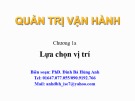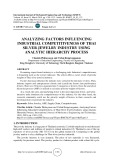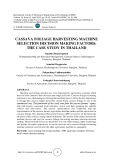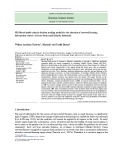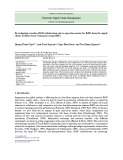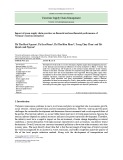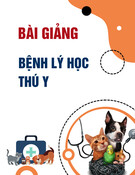
* Corresponding author.
E-mail address: wateniwut@polikant.ac.id (W. A. Teniwut)
© 2019 by the authors; licensee Growing Science, Canada.
doi: 10.5267/j.dsl.2018.8.001
Decision Science Letters 8 (2019) 137–150
Contents lists available at GrowingScience
Decision Science Letters
homepage: www.GrowingScience.com/dsl
GIS-Based multi-criteria decision making model for site selection of seaweed farming
information centre: A lesson from small islands, Indonesia
Wellem Anselmus Teniwuta*, Mariminb and Taufik Djatnab
aFisheries Agribusiness Study Program, Tual State Fisheries Polytechnic, Langgur, Southeast Maluku, Indonesia
bDepartment of Agroindustrial Technology, Faculty of Agricultural Technology, Bogor Agricultural University, Bogor, West Java,
Indonesia
C H R O N I C L E A B S T R A C T
Article history:
Received July 3, 2018
Received in revised format:
July 10, 2018
Accepted August 2, 2018
Available online
August 2, 2018
Seaweed had proven to become a fisheries commodity to provide a significant multiplier
economic effect for coastal community in Southeast Maluku District during 2005-2013.
However, the declining on the productivity of seaweed has given a direct impact on welfare of
farmers and coastal communities in this region during the recent years, due to asymmetric
information on seaweed farming associated with prices, latest technology and all pre and post
production activities. Thus, forming a dedicated information centre for seaweed farming in the
region has become a necessity. As small island regions, in Southeast Maluku district, farmers
and all stakeholder have to deal with cliché problems such as insufficient infrastructure, lack of
transportation, farmers locations that spread across the islands. This paper focused on the
selection of suitable location for the information centre for seaweed farming in Southeast Maluku
district, Indonesia. Analytical hierarchy process (AHP), in classical and fuzzy forms, was an
approach used on this study for suitability analysis. Moreover, GIS for spatial analysis in addition
to AHP was used to compare the best results for the location of information centre for seaweed
farmers. The results show that fuzzy AHP could provide more suitability location compared with
conventional AHP. Most of suitability locations were located in three sub-districts regions and
also most of them were located in Kei Kecil Island and Kei Besar Islands due to the geographical
characteristics of the region. The sensitivity analysis was conducted to measure the sensitivity of
the results when the weight of each criterion was changed. The outcome of this study was to
serve its purpose as an input and comparison study for a recent local government of Southeast
Maluku' policy on developing seaweed farming in this region.
.2018 by the authors; licensee Growing Science, Canada©
Keywords:
Seaweed farming
Small islands
Information centre
Site selection
GIS-MCDM
1. Introduction
The role of information for the success of any kind of business such as small business is significantly
high (Vaughan, 1999), despite the change of information technology has shifted the behaviour of people
(Lyu & Hwang, 2014), but the condition still cannot be applied to all regions in the world. In small
islands region especially in Indonesia, access of internet and the knowledge of using search engine is
not as much as the people who live in urban and big cities, which can affect the productivity of coastal
community’ daily activities includes fisheries. As evidence in Southeast Maluku District, where
seaweed farmers struggled to maintain their productivity in recent years due to asymmetric information
related to seaweed farming supply chain (Teniwut, et al., 2017a). Therefore, it is crucial to improve the






